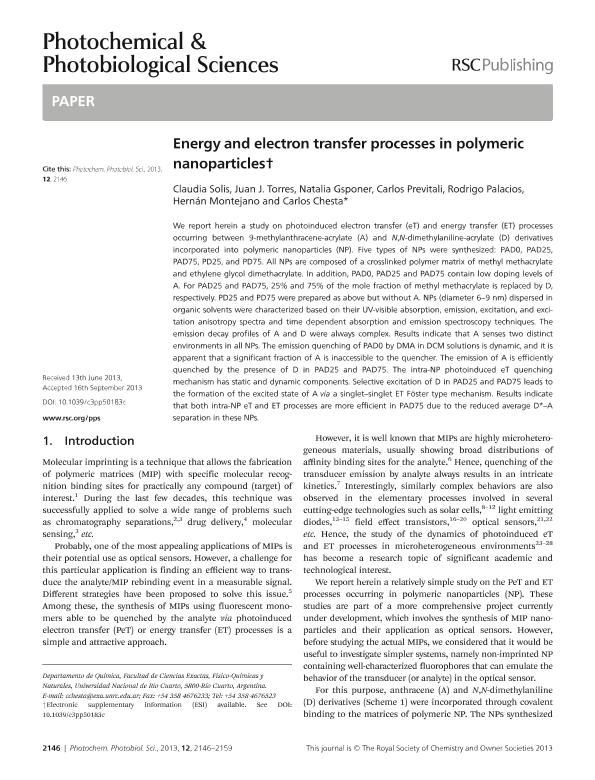Artículo
Energy and electron transfer processes in polymeric nanoparticles
Solis, Claudia Alejandra ; Torres, Juan Jose
; Torres, Juan Jose ; Gsponer, Natalia Soledad
; Gsponer, Natalia Soledad ; Previtali, Carlos Mario
; Previtali, Carlos Mario ; Palacios, Rodrigo Emiliano
; Palacios, Rodrigo Emiliano ; Montejano, Hernan Alfredo
; Montejano, Hernan Alfredo ; Chesta, Carlos Alberto
; Chesta, Carlos Alberto
 ; Torres, Juan Jose
; Torres, Juan Jose ; Gsponer, Natalia Soledad
; Gsponer, Natalia Soledad ; Previtali, Carlos Mario
; Previtali, Carlos Mario ; Palacios, Rodrigo Emiliano
; Palacios, Rodrigo Emiliano ; Montejano, Hernan Alfredo
; Montejano, Hernan Alfredo ; Chesta, Carlos Alberto
; Chesta, Carlos Alberto
Fecha de publicación:
11/2013
Editorial:
Royal Society of Chemistry
Revista:
Photochemical and Photobiological Sciences
ISSN:
1474-905X
Idioma:
Inglés
Tipo de recurso:
Artículo publicado
Clasificación temática:
Resumen
We report herein a study on photoinduced electron transfer (eT) and energy transfer (ET) processes occurring between 9-methylanthracene-acrylate (A) and N,N-dimethylaniline-acrylate (D) derivatives incorporated into polymeric nanoparticles (NP). Five types of NPs were synthesized: PAD0, PAD25, PAD75, PD25, and PD75. All NPs are composed of a crosslinked polymer matrix of methyl methacrylate and ethylene glycol dimethacrylate. In addition, PAD0, PAD25 and PAD75 contain low doping levels of A. For PAD25 and PAD75, 25% and 75% of the mole fraction of methyl methacrylate is replaced by D, respectively. PD25 and PD75 were prepared as above but without A. NPs (diameter 6–9 nm) dispersed in organic solvents were characterized based on their UV-visible absorption, emission, excitation, and excitation anisotropy spectra and time dependent absorption and emission spectroscopy techniques. The emission decay profiles of A and D were always complex. Results indicate that A senses two distinct environments in all NPs. The emission quenching of PAD0 by DMA in DCM solutions is dynamic, and it is apparent that a significant fraction of A is inaccessible to the quencher. The emission of A is efficiently quenched by the presence of D in PAD25 and PAD75. The intra-NP photoinduced eT quenching mechanism has static and dynamic components. Selective excitation of D in PAD25 and PAD75 leads to the formation of the excited state of A via a singlet–singlet ET Föster type mechanism. Results indicate that both intra-NP eT and ET processes are more efficient in PAD75 due to the reduced average D*–A separation in these NPs.
Palabras clave:
Energy Transfer
,
Electron Transfer
,
Polymeric Nanoparticles
Archivos asociados
Licencia
Identificadores
Colecciones
Articulos(CCT - CORDOBA)
Articulos de CTRO.CIENTIFICO TECNOL.CONICET - CORDOBA
Articulos de CTRO.CIENTIFICO TECNOL.CONICET - CORDOBA
Citación
Solis, Claudia Alejandra; Torres, Juan Jose; Gsponer, Natalia Soledad; Previtali, Carlos Mario; Palacios, Rodrigo Emiliano; et al.; Energy and electron transfer processes in polymeric nanoparticles; Royal Society of Chemistry; Photochemical and Photobiological Sciences; 12; 11-2013; 2146-2159
Compartir
Altmétricas



